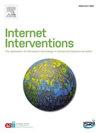智能手机认知行为疗法治疗身体畸形障碍的长期疗效:一年自然随访
IF 4.1
2区 医学
Q1 HEALTH CARE SCIENCES & SERVICES
Internet Interventions-The Application of Information Technology in Mental and Behavioural Health
Pub Date : 2025-01-22
DOI:10.1016/j.invent.2025.100803
引用次数: 0
摘要
身体畸形障碍(BDD)通常是一种慢性和损害性的精神疾病。研究表明,智能手机提供的认知行为疗法(CBT)和指导可能是一种可扩展且有效的治疗BDD的方法。然而,长期增益维持的证据有限。当前研究的目的是检查基于智能手机的认知行为治疗BDD的长期结果。方法初步诊断为BDD的成年人在教练支持下完成了为期12周的智能手机CBT课程,并在治疗后3个月和12个月进行评估。采用临床评定的耶鲁-布朗BDD强迫症量表(BDD- ybocs)评估症状严重程度、缓解程度和反应状态。次要结果也被评估,包括bdd相关的洞察力、抑郁、功能和生活质量。数据分析使用四种不同的方法来缺失数据,以最大似然估计为主要方法。结果从治疗后(n = 57)到3个月(n = 49)和12个月(n = 33)的随访有显著的减员。BDD-YBOCS严重程度评分在随访期间保持稳定[治疗后、3个月和12个月的估计平均(SE)分别为18.7(1.1)、18.9(1.2)和18.8(1.3)]。对治疗有反应和缓解的参与者比例也保持相对不变(治疗后63%的缓解者和46%的缓解者,3个月随访时分别为54%和35%,12个月随访时分别为61%和37%)。治疗后bdd相关的洞察力、功能和生活质量得到维持;从治疗后到12个月的随访,抑郁症略有增加(ES = 0.36)。结论教练支持的基于智能手机的认知行为治疗BDD的改善在治疗一年后仍能保持。本文章由计算机程序翻译,如有差异,请以英文原文为准。
Long-term outcomes of smartphone-delivered cognitive behavior therapy for body dysmorphic disorder: A one-year naturalistic follow-up
Background
Body dysmorphic disorder (BDD) is an often chronic and impairing psychiatric condition. Research shows that smartphone-delivered cognitive behavior therapy (CBT) with coaching may be a scalable and effective treatment for BDD. However, evidence for long-term gain maintenance is limited.
Objectives
The aim of the current study was to examine the long-term outcomes of a smartphone-based CBT for BDD.
Method
Adults with a primary diagnosis of BDD who completed a 12-week course of smartphone-delivered CBT with coach support were evaluated 3- and 12-months posttreatment. Symptom severity, remission and responder status were assessed with the clinician-rated Yale-Brown Obsessive-Compulsive Scale modified for BDD (BDD-YBOCS). Secondary outcomes were also evaluated and included BDD-related insight, depression, functioning and quality of life. Data were analyzed using four different approaches to missing data, with maximum likelihood estimation as the main approach.
Results
There was significant attrition from posttreatment (n = 57) to 3-month (n = 49) and 12-month (n = 33) follow-up. The mean BDD-YBOCS severity score remained stable during the follow-up period [Estimated Mean (SE) at posttreatment, 3-months, and 12-months = 18.7(1.1), 18.9(1.2) and 18.8(1.3), respectively]. The proportion of participants responding to treatment and in remission remained relatively unchanged as well (63 % responders and 46 % remitters at posttreatment, 54 % and 35 % at 3-month follow-up, and 61 % and 37 % at 12-month follow-up, respectively). Posttreatment gains in BDD-related insight, functioning, and quality of life were maintained; there were small increases in depression (ES = 0.36) from posttreatment to 12-month follow-up.
Conclusions
Improvements after coach-supported smartphone-based CBT for BDD are maintained one year after treatment.
求助全文
通过发布文献求助,成功后即可免费获取论文全文。
去求助
来源期刊

Internet Interventions-The Application of Information Technology in Mental and Behavioural Health
Medicine-Health Informatics
CiteScore
6.50
自引率
9.30%
发文量
94
审稿时长
6 weeks
期刊介绍:
Official Journal of the European Society for Research on Internet Interventions (ESRII) and the International Society for Research on Internet Interventions (ISRII).
The aim of Internet Interventions is to publish scientific, peer-reviewed, high-impact research on Internet interventions and related areas.
Internet Interventions welcomes papers on the following subjects:
• Intervention studies targeting the promotion of mental health and featuring the Internet and/or technologies using the Internet as an underlying technology, e.g. computers, smartphone devices, tablets, sensors
• Implementation and dissemination of Internet interventions
• Integration of Internet interventions into existing systems of care
• Descriptions of development and deployment infrastructures
• Internet intervention methodology and theory papers
• Internet-based epidemiology
• Descriptions of new Internet-based technologies and experiments with clinical applications
• Economics of internet interventions (cost-effectiveness)
• Health care policy and Internet interventions
• The role of culture in Internet intervention
• Internet psychometrics
• Ethical issues pertaining to Internet interventions and measurements
• Human-computer interaction and usability research with clinical implications
• Systematic reviews and meta-analysis on Internet interventions
 求助内容:
求助内容: 应助结果提醒方式:
应助结果提醒方式:


